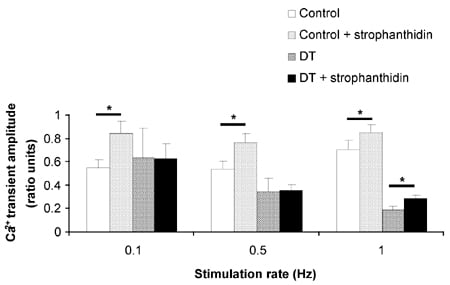Increasing stimulation rate increases intracellular Na+ ([Na+]i) which, via sodium-calcium exchange (NCX), increases Ca2+ transient amplitude, and hence the strength of contraction of cardiac ventricular myocytes (e.g. Harrison et al. 1992). Previous work has shown that NCX is located predominantly in the t-tubules of ventricular myocytes (Yang et al. 2002); the aim of the present study was to investigate the effects of detubulation on the response to increasing stimulation rate.
Wistar rats (200-250 g) were humanely killed and ventricular myocytes isolated by enzymatic digestion. Cells were detubulated (DT) using formamide as described previously (Yang et al. 2002). Intracellular Ca2+ ([Ca2+]i) and [Na+]i were monitored using fura-2 and SBFI, respectively, and cell length monitored optically. Experiments were performed at 22-24 °C.
Figure 1 shows the relationship between Ca2+ transient amplitude and stimulation frequency in control and DT myocytes. This relationship was slightly positive in control cells but negative in DT cells. However the change in [Na+]i caused by changing from 0 to 1 Hz stimulation was not significantly different (Student’s unpaired t test) in control (3.5 ± 1.2 mM, n = 8) and DT (4.7 ± 1.6 mM, n = 7) cells.
In the presence of strophanthidin (100 µM), to reduce Na+ efflux via the Na+-K+-ATPase, the stimulation-induced increase in [Na+]i was significantly greater (P < 0.05; paired t test) in control (10.6 ± 1.2 mM, n = 8) and DT (9 ± 1.8 mM, n = 7) cells, but the increase was not significantly different (unpaired t test) between control and DT cells. In control cells, this was associated with a significant increase in the Ca2+ transient at each frequency resulting in a flatter Ca2+ transient-frequency relationship. In DT cells, strophanthidin only increased Ca2+ transient amplitude at 1 Hz, and the Ca2+ transient-frequency relationship was still negative.
These data show that ion regulation in the t-tubules is an important determinant of the Ca2+ transient/ contraction- frequency relationship. Although [Na+]i rose to the same extent in control and DT cells when stimulation rate was increased and when strophanthidin was added, this was not translated into an increased Ca2+ transient in DT cells, consistent with the t-tubules being an important site of NCX activity. However the observation that strophanthidin increased [Na+]i in detubulated cells, and caused a small increase in [Ca2+]i at 1 Hz suggests that some Na+-K+-ATPase and NCX are located on the surface membrane.
This work was supported by the British Heart Foundation and Wellcome Trust.

